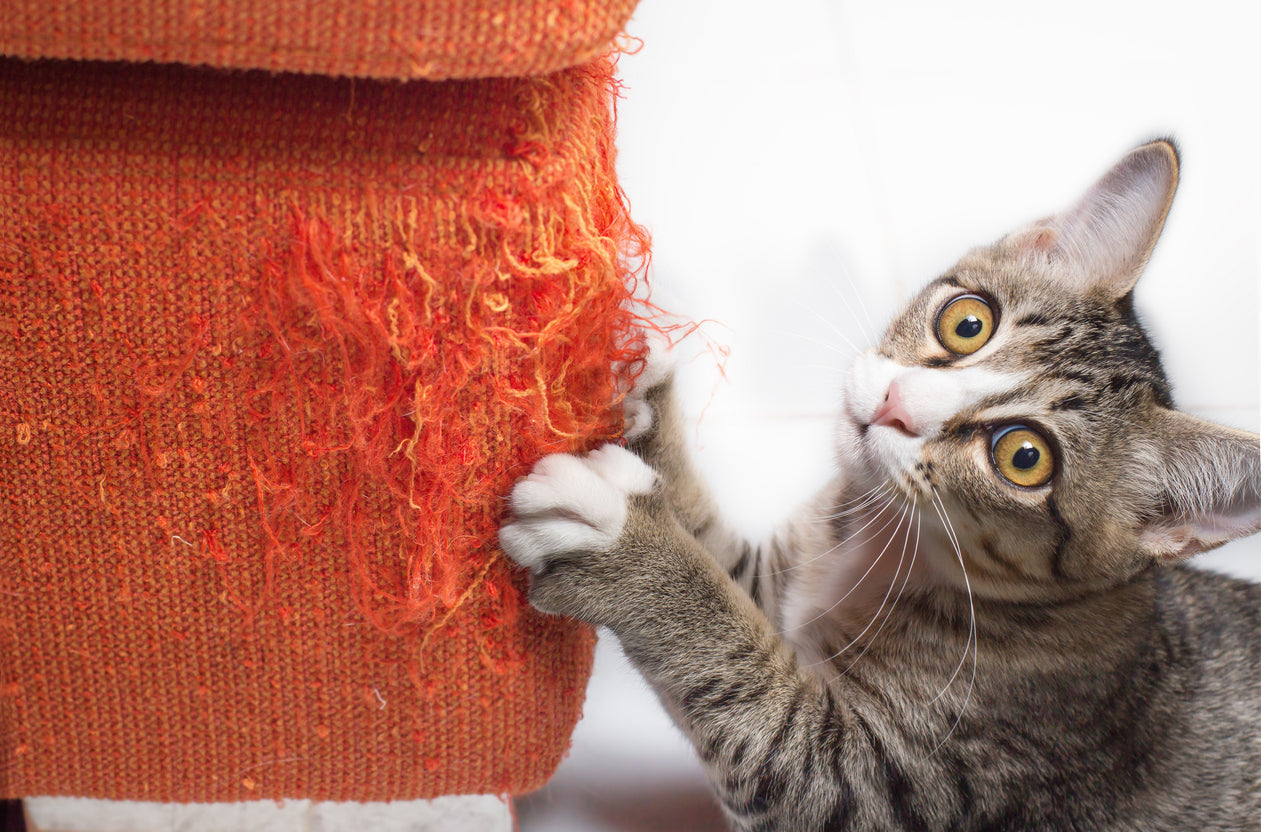How to Stop Cats from Scratching Furniture

Cats are wonderful companions and cute as anything, but one drawback makes families a little apprehensive about adding a feline member to their family. They are furniture murderers. They love to climb, scratch and chew furniture. And they're not picky about what type. Whether it's made of wood or covered in fabric, cats aren't biased regarding which to annihilate.
This behaviour can be frustrating, especially regarding furniture you've saved a pretty penny to invest in.
However, there is a rhyme and reason for this behaviour. Understanding why cats scratch and then using the right methods to stop them can help preserve your furniture while ensuring your feline friend remains healthy and happy.
So, let's explore how to stop cats from scratching furniture and why they do it in the first place.
Why Do Cats Scratch Furniture?

Before diving into the solutions, understanding why cats scratch in the first place will give you a better perspective on addressing the behaviour and providing solutions. Scratching is natural and instinctive for cats and serves several important purposes :
Marking Territory: Cats have scent glands in their paws. Scratching is a way for them to mark their territory and leave their scent behind.
Stretching and Exercise: Scratching helps cats stretch their muscles and provides an outlet for pent-up energy.
Sharpening Claws: Cats scratch to keep their claws sharp and healthy. It's part of their grooming routine.
Given that scratching is a natural behaviour, it's not about stopping your cat from doing it. Instead, your intent should be to redirect this behaviour. Here's how:
Scratching Posts. Lots Of Scratching Posts

Add scratching posts to your home decor and feng shui. It's every interior designer's worst nightmare, but this is one of the most effective ways to stop your cat from scratching furniture. And cats love variety, so be prepared for a few different types of eye sores:
Vertical Scratching Posts: Some cats love to scratch upwards. A tall, sturdy post or a cat tree can work wonders.
Horizontal Scratching Pads: If your cat prefers scratching on the ground, consider a horizontal scratching pad made from cardboard or sisal.
Scratching Surfaces with Different Textures: Cats are picky about texture, so it's worth trying materials like sisal, cardboard, or even carpet.
Place these scratching posts in areas where your cat already likes to scratch, especially near their favourite furniture.
Use Furniture Protectors

While you work on redirecting your cat's scratching habits, you might want to implement ways of protecting your furniture.
Furniture protectors or double-sided tape are excellent tools for deterring scratching. Cats dislike the sticky texture of tape, so when they scratch the protected area, they quickly learn to avoid it. If you do a quick search on Amazon, you'll find big sheets of double-sided tape specifically to deter cats from our precious furniture. They will learn, but be aware that it may take time.
You can also use furniture slipcovers or special scratch-proof pads to safeguard your valuable pieces while offering your cat other options.
Cut Those Claws

Keeping your cat's claws trimmed is an obvious one. While trimming won't stop the scratching behaviour, it can prevent their claws from causing catastrophic damage to your furniture.
Use a pair of cat-specific nail clippers to trim the sharp tips of your cat's claws. If you're unsure how to trim your cat's claws, ask your vet or a professional groomer. Failing that, head to YouTube, where there are tutorials for everything.
Deter & Distract

Several cat-safe sprays are available that can help deter scratching. These sprays have scents that cats find unpleasant but are harmless to them.
Simply apply the spray to your furniture and watch your cat lose interest in scratching that area.
Positive Reinforcement and Training

Cats can learn new behaviours with positive reinforcement. When your cat uses the scratching post instead of your furniture, reward them with treats, praise, or a little playtime.
On the flip side, if your cat continues to scratch furniture, avoid punishment, as this can confuse and stress them out.
Instead, gently redirect your cat to the scratching post when you catch them in the act. Over time, they will learn where they are allowed to scratch.
Keep ‘Em Busy

Boredom can lead to unwanted behaviours like excessive scratching. To keep your cat engaged, ensure it has plenty of toys, climbing spaces, and mental stimulation.
Puzzle feeders, interactive toys, and cat trees will help keep your cat entertained, reducing their need to scratch out of boredom.
Dealing with a cat that scratches furniture doesn't have to be a nightmare.
Remember, scratching furniture is a natural, instinctive behaviour. With patience, positive reinforcement, and a bit of creativity, you can guide your cat towards better scratching habits and keep your beloved furniture safe.
-
At Pet Food Australia, we understand how much you care about your pets and your home. Explore our range of products, from nutritious food to tempting treats, designed to keep your cat healthy and happy.













